#Juvenal
Text
Latin Literature Tournament - Round 1


Propaganda under the cut!
Pliny Propaganda:
His description of Vesuvius is so fucking cool and important, you guys. It's so cool that "Plinian eruptions" are a thing in volcanology
He writes some neat descriptions of gardens and private horticulture, so he's an important source on Roman aesthetics of domestic design
His letters really are bangers. I love his friendship with Tacitus, and the ghost stories are so fucking fun
Juvenal Propaganda:
I love reading and fighting Juvenal. He is such an asshole and so full of shit (and his poems really are a blast)
That said the man sure can turn a phrase. Bread and circuses, anyone?
Is that a farrago in your libellus or are you just happy to see me
#tagamemnon#classics#pliny#pliny the younger#juvenal#latin#latin literature#latin literature tournament#tumblr polls#tournament polls#bracket#satire#letters#epistolography
45 notes
·
View notes
Text
"i'm not being serious, it's just satire!" "it's not satire if it's indistinguishable from the thing it claims to satirize!" actually it's only satire if it
is written in dactylic hexameter
primarily concerns everyday topics
contains elaborate intertextual references to both epic poetry and other genres
1K notes
·
View notes
Photo

BEAUX SPÉCIMENS DE LA RACE. 1. Farnèze, par Tigre d’Étruval et La Marquise, 1er prix des Étalons 4 ans; à M. Le Gentil. 2. Marmotte, Jument 1er prix Boulogne. 3. Lucifer, par Campagnol et Charmante, 1er prix des Étalons de 3 ans Paris; à MM. Calais. 4. Beuvriguen, Étalon 3 ans, 1er prix; à MM. Calais. 5. Tribun, Étalon gris né en 1919, 1 m. 64, Champion Paris et Boulogne, Société Coopérative de St-Pol. 6. Juvenal, Étalon gris, 1 m. 64; à M. Le Gentil. 7. Boulonnais, vu de dos; 8. Pomponne, Pouliche de 3 ans, 1er prix Paris; à M. de Wazières.
(Studios Vie à la Campagne et Cl. Chambry.)
Vie à la Campagne, Vol. 65, 15 Octobre 1930
#Boulonnais#chevaux#cheval de trait#étalon#Farnèze#Lucifer#Beuvriguen#Tribun#Juvenal#jument#Marmotte#pouliche#Pomponne#heavy horse#draught horse#draft horse#1930#Cl. Chambry
25 notes
·
View notes
Text



I love it when the editor/commentator gets their knickers in a twist over the Romans' general lack of prudishness
#iuvenalis#juvenal#queueusque tandem abutere catilina patientia nostra#tagamemnon#dark academia#grey academia#chaotic academia#satura#poetry#latin#latin language#classic academia#classical studies#books#book photography#classics#ἐποίησα
20 notes
·
View notes
Text

juvenal satires
467 notes
·
View notes
Photo
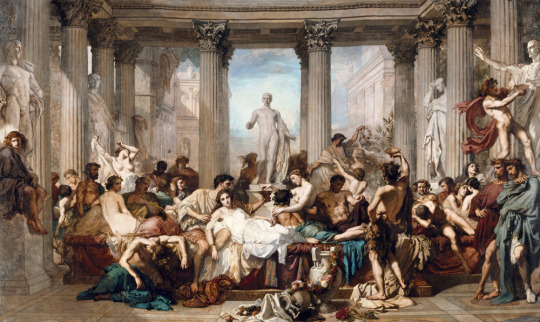

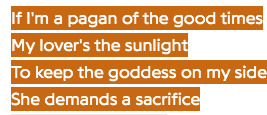


Thomas Couture // Juvenal // Hozier // John William Waterhouse // Florence + The Machine
#web weaving#dark academia#light academia#romantic academia#thomas couture#juvenal#hozier#john william waterhouse#florence + the machine#ancient rome#moodboard#circe#poetry#lyrics#quotes#history#mythology#music#academiaaesthetic#art academia
124 notes
·
View notes
Text
The Proper Object of Prayer
Juvenal, Satires X.346-362
Note: Sardanapalus was a legendary king of Assyria, used among Greeks and Romans as a byword for luxury and extravagance.
Will people then wish for nothing? If you want my advice,
You’ll let the gods themselves weigh out what befits us,
What’s useful for our affairs; for in lieu of what’s pleasing,
The gods give whatever’s most apt. Humanity’s more dear
To them than to itself: we, driven by the impulse
Of our minds, by blind and overwhelming desire,
Seek out brides and offspring; but they take note of what
Children we’ll have, of what sort our wives will be.
But so that you may ask something, that you may vow
The innards and holy sausages of a little white pig in shrines,
One ought to pray for a sound mind in a sound body.
Ask for a brave spirit, one lacking fear of death,
That reckons span of life last among nature’s gifts,
That can bear whatever labors you like, doesn’t know how
To get angry, desires nothing, and believes that Hercules’ woes,
His savage labors, are greater than the love-affairs
And banquets and feathery cushions of Sardanapalus.
nil ergo optabunt homines? si consilium uis,
permittes ipsis expendere numinibus quid
conueniat nobis rebusque sit utile nostris;
nam pro iucundis aptissima quaeque dabunt di.
carior est illis homo quam sibi. nos animorum
inpulsu et caeca magnaque cupidine ducti
coniugium petimus partumque uxoris, at illis
notum qui pueri qualisque futura sit uxor.
ut tamen et poscas aliquid uoueasque sacellis
exta et candiduli diuina tomacula porci,
orandum est ut sit mens sana in corpore sano.
fortem posce animum mortis terrore carentem,
qui spatium uitae extremum inter munera ponat
naturae, qui ferre queat quoscumque labores,
nesciat irasci, cupiat nihil et potiores
Herculis aerumnas credat saeuosque labores
et uenere et cenis et pluma Sardanapalli.

Hercules at the Crossroads, Albrecht Dürer, ca. 1498
#classics#tagamemnon#Latin#Latin language#lingua latina#langblr#translation#Latin translation#poem#poetry#poetry in translation#Juvenal#satire#Ancient Rome#Roman Empire#dactylic hexameter#albrecht dürer
45 notes
·
View notes
Text
Evening in Ancient Rome.
Do you see all that steam and bustle? A hundred hangers-on,
each followed by his scullion, are getting their free dinners.
A strongman could scarcely tote those outsize dixies,
all the gear one poor little servant must balance on his head,
trotting briskly along to keep the charcoal glowing.
Juvenal, Satire 3.249-253
20 notes
·
View notes
Note
I'd love to see you talk about resident angsty teen Juvenal and posterchild Horace xD
love your blog!!!
Why, thank you! Alas, I do not know very much about Roman poets and satirists. I'm more into the politics/sociology side of history.
But if you haven't seen it already, I think you would love @ovidiana's work! Their comic, the Dead Romans Society, is really funny, touching, and heartfelt. I especially enjoy the artist's skill with characterization and portraying grief. Horace makes a bunch of appearances, and Juvenal's shown up a couple times, too.
8 notes
·
View notes
Text
'Nature, in giving tears to man, confessed that he had a tender heart; this is our noblest quality.' -

10 notes
·
View notes
Text
»Kleine rote Fische, die rückwärtsgehen« - Eine Kulturgeschichte der Krebse
Buchvorstellung
Mit ihren starren Panzern, vier Beinen und zupackenden Scheren sind Krebse faszinierende Tiere. Aufgrund ihres oft delikaten und gesunden Fleisches wurde auf dem KRAUTJUNKER bisher nur ihr Fang und ihre Zubereitung in der Küche oder im Dutch Oven gezeigt.
»Kleine rote Fische, die rückwärtsgehen« – Eine Kulturgeschichte der Krebse ist aus der Perspektive eines Naturforschers…

View On WordPress
#Angelblog#Armeleuteessen#Buchvorstellung#die rückwärtsgehen« - Eine Kulturgeschichte der Krebse#Follow the science#Foodblog#Georges Cuvier#Heikegani#Heikopsis japonica#Heinz-Dieter Franke#Hummertelefon#Juvenal#Kleine rote Fische die rückwärts gehen#Kleine rote Fische die rückwärtsgehen Eine Kulturgeschichte der Krebse#Kulturgeschichte der Krebse#Luxusspeise#Mare Verlag#Rezension#Samurai-Krabben#Sir Robert Moray
2 notes
·
View notes
Text
Learning and Reading Before Gutenberg
So I attended a lecture at my college yesterday on pre-Gutenberg manuscripts; some of the special collections folks from UGA came up to our campus to show us some of these, including Dr. Cynthia Camp, a really established medievalist! Here’s some pictures of all the ones she showed us today.
(Medievalist friends, this all might seem pretty obvious to you, but this is brand new information for me; please find it in your heart to forgive my excitement and any misspellings. This is also kind of a long post, so I'm putting it under a read more to save your dash. Classicist friends, I promise there's something here for you too; lots of Latin and a book full of Juvenal!)
Office of the Dead
This huge thing below is an Office of the Dead, a Catholic book of prayers to help the dead get through Purgatory faster. This particular one is from St. Cunebert’s monastery in Cologne, and the necrography indicates that it was in use from the 16th century all the way up until to the 18th century.

The cover is made of wood, mostly, but there are little bits of brass that are super easily tarnished by skin oils, so gloves are important.

Some old style musical notation, with lyrics in Latin.
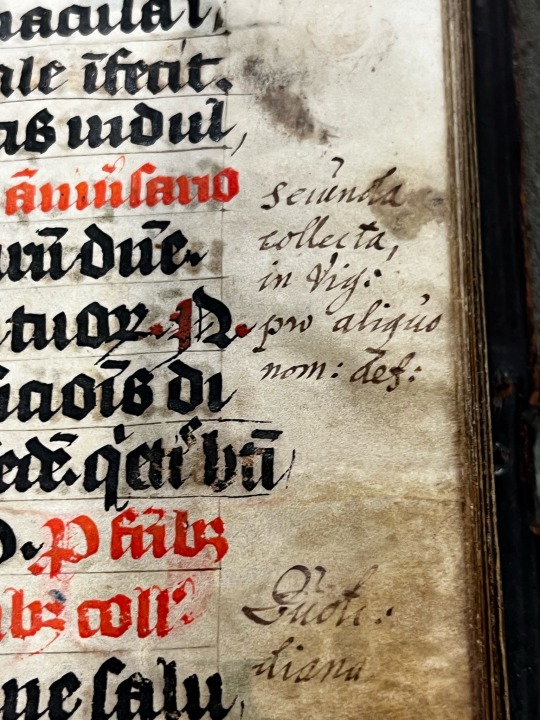

Marginalia in the form of corrections on the side. I’m not exactly sure of the meaning of the marginalia on the left, but the one on the right is an addition of benefactors (et benefactores) to a prayer.

Check out this insanely ornate floral initial! And all the marginalia on the left! (also you're about to see a massive drop in quality because I had to switch to desktop and had to compress all the images down)

Here’s a particularly well loved page; you can see all the finger dirt on the corners of the vellum. The red letters are called rubrics (from Latin ruber, meaning red) and helped users to find particular passages or pages in an age before page numbers. You can also see the ruling lines the monks used to make sure everything was uniform; they look a lot like the guides and lines you'll see in a lot of modern digital art programs today, especially typography programs like Adobe InDesign.
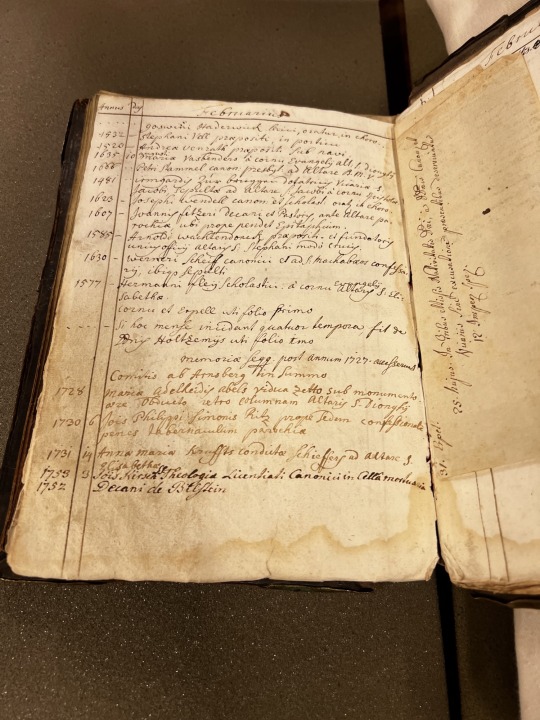
This page here is the necrography I mentioned earlier; it’s a log of every deceased person the monastery has taken charge of since the book was made. The lists are organized by month (pictured here is the page for February, Februarius) with separate columns for the year (annus) and day (dies), if it’s known. Notice the difference in material and in hand; that’s because this necrography is a new addition from 1727. Actual paper is used here instead of parchment or vellum, but I can’t really explain the use of cursive instead of bookhand.
Book of Hours
This is a Catholic prayer book, much like the Office of the Dead, except that the usage cases are much different; this Book of Hours is actually intended for personal use, for those richer folks who would rather pray for themselves than have some random monk to pray for them. Not everyone with a chunk of money could afford these books, though; the cost of one of these in the Middle Ages is equivalent to what a new car costs today!

Though it's kind of hard to see, this one has a velvet binding. Many Medieval books had velvet covers, but because they don't survive super well, it's not odd for them to get a new, modern cover.

At the beginning of the book, there's a calendar with a bunch of saints' feast days. Check out the shiny golden roman numerals up top!

The gold (not super sure if it's paint or leaf) also makes an appearance in the initials and borders around the text. There's lots of beautiful, detailed floral marginalia here too; I'll probably post a better-quality picture of this in the future.
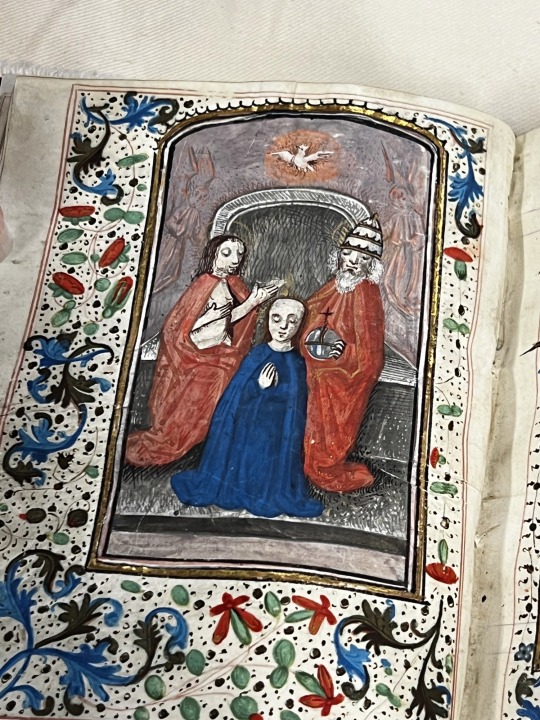
This illustration comes just before the Office of the Virgin, a set of prayers to the Virgin Mary and the Holy Trinity. Here we see the Virgin Mary draped in blue, as this was a common motif used to distinguish her from other figures in an image in this time period. Surrounding her are representations of the Holy Trinity; from right to left, then up, are the Father, the Son, and the Holy Spirit in the form of a haloed dove.
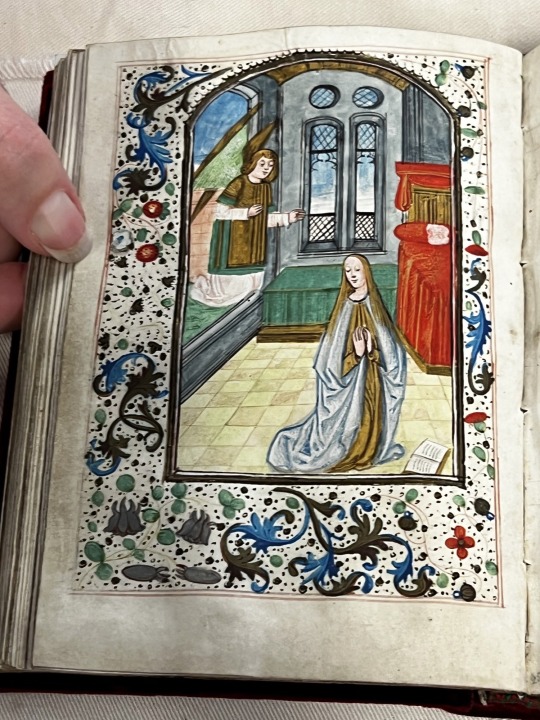
This image in the middle of the Office of the Virgin depicts the Enunciation, or rather, the 30 seconds before the Enunciation. We can see the Virgin Mary on the floor, praying on the floor out of a little book much like the one the drawing is contained in, possibly providing an example on how to pray. Notice how she hasn't noticed the angel Gabriel's presence, as she isn't totally freaking out about the fact that a giant guy with wings has flown through her window and is telling her that, in Dr. Camp's words, "God said, 'Tag, you're it." If Gabriel was saying anything, we would probably also see a little haloed dove representative of the Holy Spirit flying in through the window to impregnate her, as that was a popular motif used to depict the Immaculate Conception. Also notice that the interior design is much more like that of Medieval Europe than that of Biblical Israel; whether that was a deliberate choice on the part of the illustrator or just the product of a lack of information, I don't think we'll ever know.
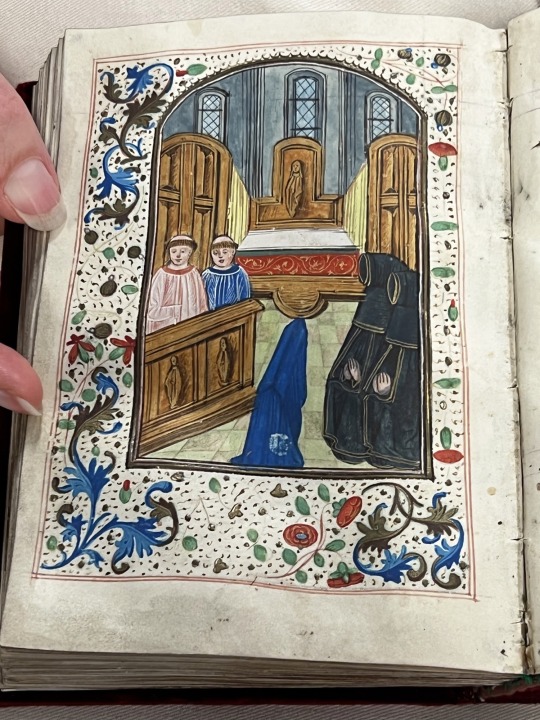
This book has an Office of the Dead as well, and this is the illustration that proceeds it. On first glance, I thought the red and gold box near the back was a casket; apparently, that's actually the High Altar, and the thing draped in blue is the casket lying in state. I suspect the monk who illustrated this wasn't the best at perspective, but I don't blame him; I struggle with it myself sometimes, even with all of the tech I have.
Psaltery
This is actually the oldest book UGA has on loan right now. All of the other books are from that weird, 150-year transition period where handwritten books and printed books co-existed, but this is from even before the invention of the printing press; truly, this is pre-Gutenberg. One can tell, too; a lot of the pages are worn and well loved, and some of the illustrations have lost their paint and detail over the years, but a few (which I'll show here) have kept their charm marvelously.

At first glance, the metal clasps on this book might make you think of those clasped diaries all the girls had in middle school to keep their little brothers from reading it; that was certainly my first thought, and it was the first thought of many of the other attendees as well. However, their purpose becomes much more apparent when you think of the material the pages were made of; vellum, essentially very thin leather. Leather of any kind stretches and warps in the face of age and humidity, so keeping the book clasped shut tight when not in use kept the pages from warping too much.
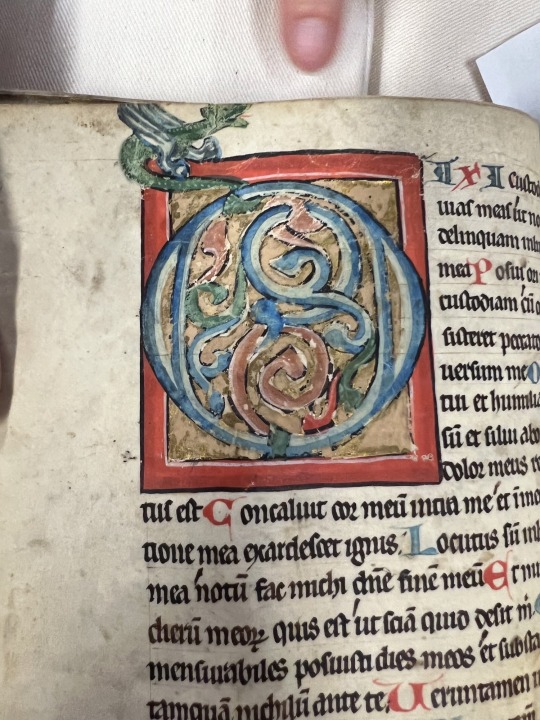
This initial seems to be taking a lot of cues from Saxon "intertwined animal" styled art. Also, look at the tiny little dragon up top! He's trying so hard to be threatening...
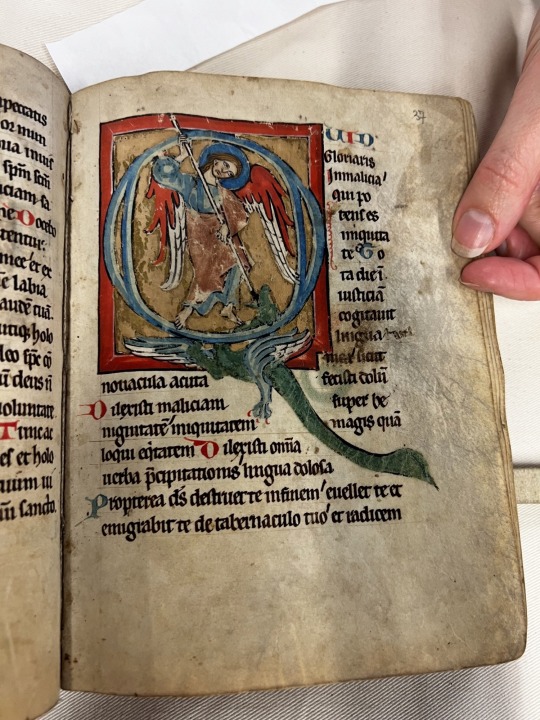
Speaking of dragons, look at this one! This here is an example of what's deemed an inhabited initial, or an initial containing a human figure doing something. On first glance, I thought this was an image of St. George, since slaying dragons is something he's associated with. I was informed later that this is actually an image of the Archangel Michael, as going around and slaying a bunch of dragons (and sometimes the devil) is something he does a lot, too. I should have seen the wings and the halo, looking back. I also thought the letter in the initial was an "O", but I was also informed it was actually a "Q", with the dragon's tail making the dash and the whole first word being quid (meaning "what" or "something" and used in the neuter in place of quis). Just another example of how surprising and layered these illustrations can be, especially to modern eyes who haven't been to Sunday school in a hot minute like mine!
Iuvenalis Opera (Works of Juvenal)
Okay, now it's time for a shift from the religious to the secular, and classicist friends, it's time for the bit you've been waiting so patiently for. This is a book of Juvenal's Satires transcribed by Humanist thinkers in the close to what we'd consider the cusp between the Medieval period and the Renaissance. There's a really interesting theme in the entire Medieval period when it comes to the change in general cultural attitude towards Classical ideas; there's a huge rejection of these ideas in the beginning few decades after the fall of Rome, exchanging in favor of something more uniquely Christian (read: northern/western European), but the pendulum begins slowly swinging the other way by the time of Charlemagne. The Humanist school of thought is the closest Western Europe comes to liking and using Classical ideas widely again before we hit the true start of the Renaissance. The humanists were dedicated to preserving the works of the great Roman poets, like Vergil and Juvenal, and trying to distinguish between what was original to their works and what was added over time by other authors.

A lot of the other attendants said that the cover looked a lot like a spell book or a grimoire... ah, I wish. No spells here; it's just an angry Roman poet lampooning the world.
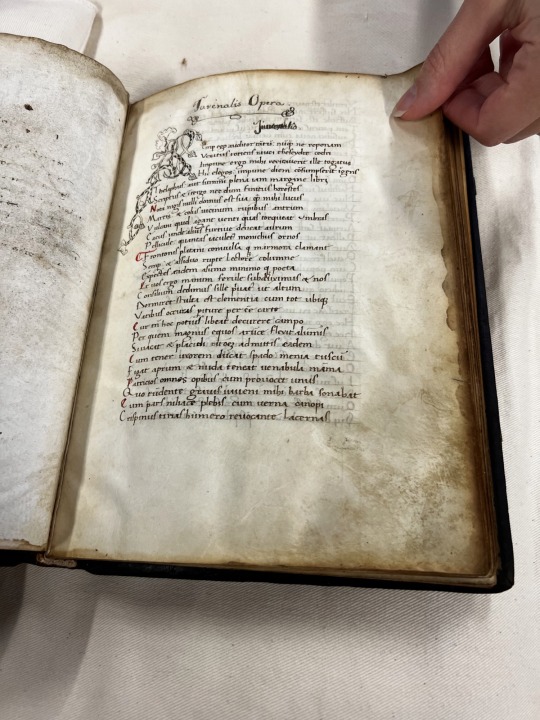

The other thing the humanists tried to do was revive the Roman way of making and transcribing books, or, at least what they thought the Roman way of writing looked like. It's actually Carolingian hand, but hey, at least they made it legible!
Commentary on Peter Lombard's Sentences
Okay, this one was super near the end of the lecture and by this point, my attention was wandering. All I could say about this one was it was UTTERLY UNREADABLE. Like, dense, messy, shitty writing with barely enough rubrics to keep up. Apparently, if you were in college in the Middle Ages, this is what you'd use as Cliff Notes. Don't think I'd want to use it, though...
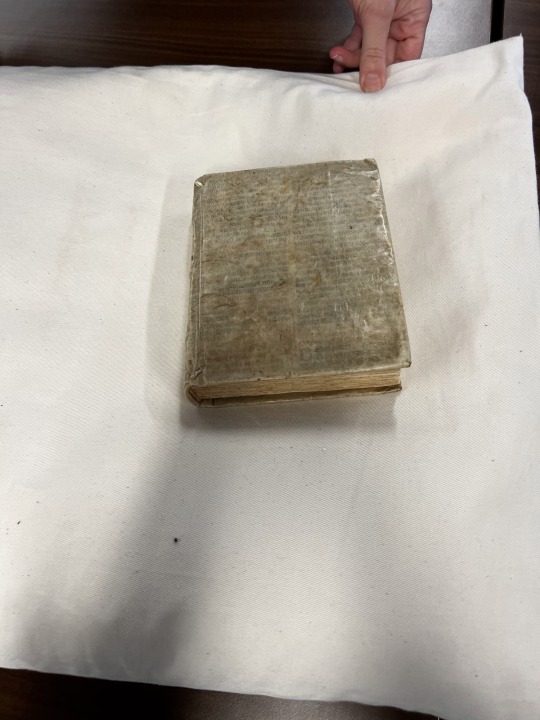
What a lecture! Again, thank you to Dr. Cynthia Camp and the rest of the team from UGA Special Collections for bringing these wonderful artifacts up to our small, rinky-dink little mountain campus.
#classicist friends you'll like this one too#latin language#lingua latina#latin langblr#art history#medieval art#medieval history#juvenal#god this was the coolest thing I've done in a long time#catholic art#catholiscism#christianity#roman catholicism
33 notes
·
View notes
Text
“Consider it the greatest of crimes to prefer survival to honour and, out of love of physical life, to lose the very reason for living.”
- Latin poet Juvenal
3 notes
·
View notes
Text
The London theatres then presented a spectacle which ought for ever to put to silence the foolish outcry against progressive deterioration of morals, - foolish even from the pen of Juvenal, and still more from the lips of a modern Puritan. Vice is always nearly on an average: The only difference in life worth tracing, is that of manners, and there we have manifestly the advantage of our ancestors.
Charles Robert Maturin, Melmoth the Wanderer
#quote#quotation#Charles Robert Maturin#Melmoth the Wanderer#London#theatre#spectacle#foolish#outcry#deterioration#morals#Juvenal#Puritan#vice#average#manners#advantage#ancestors
4 notes
·
View notes
Photo

6 notes
·
View notes





